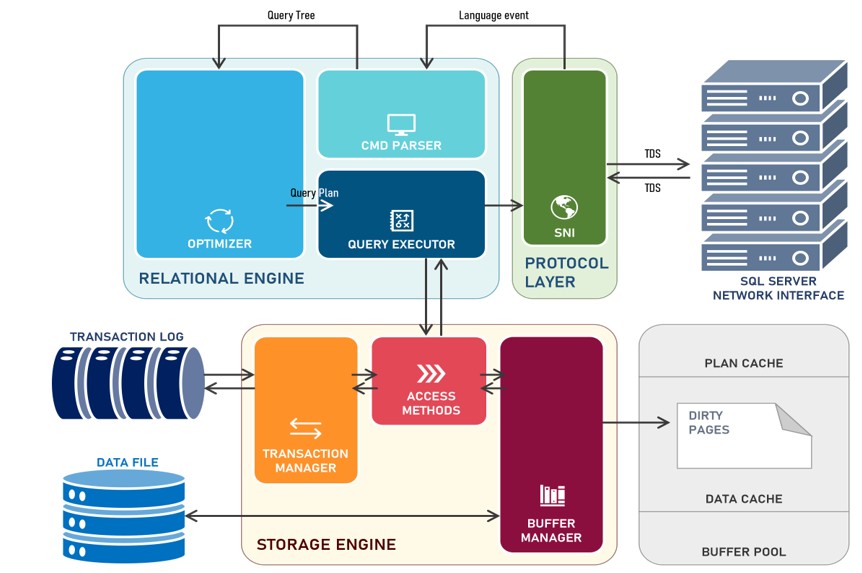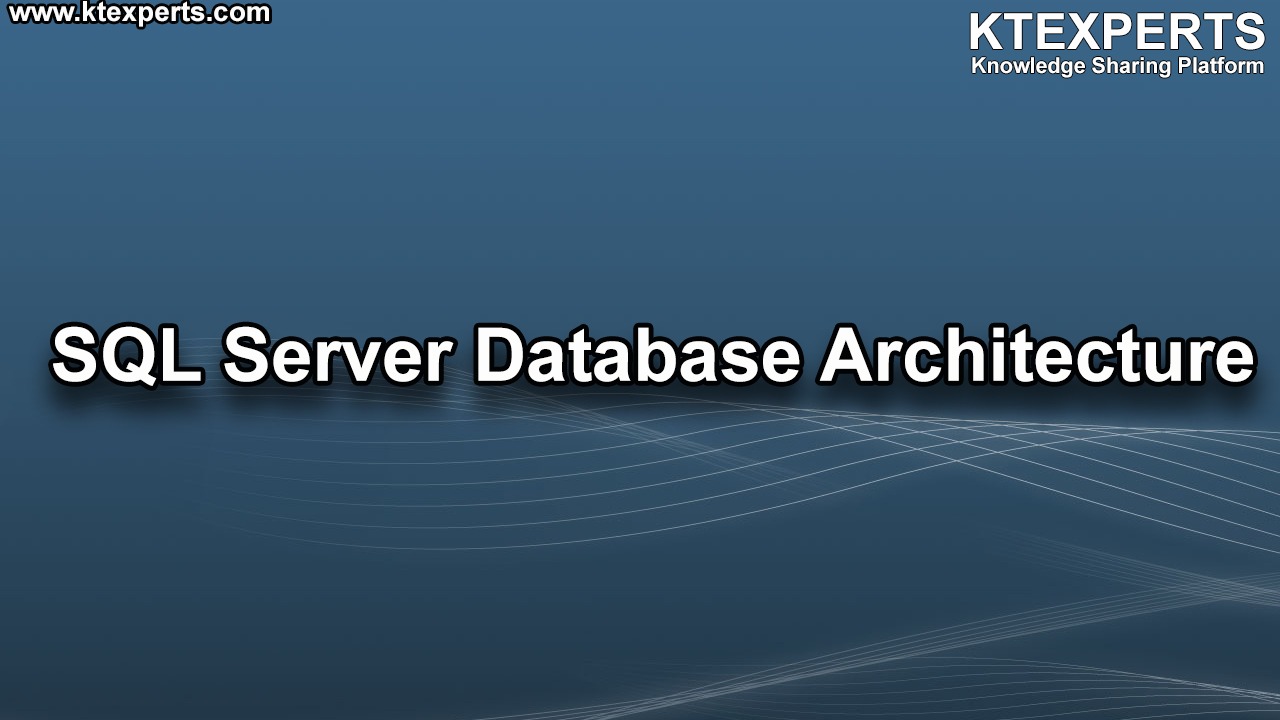Understanding SQL Server Architecture

Microsoft SQL Server is a relational database management system (RDBMS) designed to store, manage and retrieve data efficiently. To achieve high performance, reliability and scalability SQL Server is structured into several inter-related components that work together to process user queries, manage data and ensure data integrity. Below is the overview of this architecture, illustrating how SQL Server handles client requests, processes queries and interacts with physical storage.

Broadly SQL Server’s architecture can be divided into three main layers:
- Protocol Layer
- Relational Engine
- Storage Engine

Let’s explore each of these layers and their internal components in detail.
The Protocol Layer
The Protocol Layer serves as the entry point for all communication between SQL Server and client applications. It is responsible for managing the network protocols that allow applications to connect to the SQL Server instance.
When a client sends a request (for example, a select query), the Protocol Layer receives it through the SQL Server Network Interface (SNI). SNI supports several communication protocols such as:
– TCP/IP
– Named Pipes
– Shared Memory
The SQL Server Network Interface ensures that the incoming client request is properly packaged and delivered to the Relational Engine for further processing. Likewise, it handles the reverse process for sending query results back to the client.
The Protocol Layer functions as the translator and messenger, enabling SQL Server to communicate efficiently with external applications.
The Relational Engine
Also known as the Query Processor, the Relational Engine is the brain of SQL Server. It is responsible for interpreting and executing SQL queries. This engine focuses on the logical aspects of data processing: what data is requested and how it should be retrieved.
The Relational Engine consists of several key components:
Command Parser
The Command Parser is the first stage in the query processing pipeline. When a SQL query arrives, the parser checks it for syntax errors and converts it into an internal format called a Query Tree (or Parse Tree). This tree represents the logical steps needed to execute the query.
Optimizer
The Query Optimizer is one of the most critical components of SQL Server. Its job is to determine the most efficient way to execute a query. Given multiple possible execution paths, the optimizer estimates the cost (in terms of CPU, I/O, and memory usage) for each and selects the least expensive plan.
This process results in the generation of an Execution Plan, which specifies how the data will be retrieved or modified: what indexes will be used, how joins will be processed, and in what order operations will occur.
Query Executor
Once the execution plan is ready, it is handed over to the Query Executor, which carries out the plan’s operations. The executor interacts closely with the Storage Engine to fetch or modify the required data. During execution, the engine may reuse existing plans from the Plan Cache to improve performance.
In essence, the Relational Engine manages query compilation, optimization, and execution, ensuring queries run efficiently.
The Storage Engine
While the Relational Engine decides what data to fetch and how, the Storage Engine handles where and how the data is physically stored and accessed. It is responsible for managing data files, indexes, transactions, and buffer memory.
The Storage Engine consists of several crucial components:
Access Methods
The Access Methods component acts as an intermediary between the Relational Engine and the physical storage. It provides low-level routines for reading and writing data pages, managing indexes, and maintaining data consistency. Whenever the Query Executor needs to retrieve or modify data, it issues a request through the Access Methods interface.
Buffer Manager
The Buffer Manager manages the in-memory data cache known as the Buffer Pool. Since reading data from disk is slow, SQL Server loads frequently accessed data pages into memory for faster access. The Buffer Manager tracks which pages are dirty pages (modified but not yet written to disk) and coordinates their flushing to storage as needed.
The Buffer Manager includes:
Data Cache: Stores recently accessed data pages.
Dirty Pages: Tracks modified pages that need to be written back to disk.
Plan Cache: Stores compiled execution plans for reuse.
Efficient management of the buffer pool is vital for performance as it minimizes disk I/O and speeds up query execution.
Plan and Data Caching:
Caching plays a central role in SQL Server performance. The Plan Cache stores previously compiled execution plans to avoid repetitive optimization steps for similar queries. The Data Cache, on the other hand, holds frequently used data pages in memory.
When a query is executed, SQL Server first checks the Plan Cache to see if an existing plan can be reused. Similarly, the Buffer Manager checks whether the required data pages are already in memory. These optimizations greatly reduce processing time and improve overall efficiency.
Transaction Manager
SQL Server is designed to guarantee the ACID properties (Atomicity, Consistency, Isolation Durability) of transactions. The Transaction Manager ensures that all operations within a transaction are either fully completed or fully rolled back in case of failure.
It coordinates with the Log Manager to record every change in the Transaction Log, ensuring durability and recoverability. This component also handles concurrency control using mechanisms such as locks and latches to prevent data conflicts when multiple users access the same data simultaneously.
Interaction Between Components
The overall flow of operations in SQL Server can be summarized as follows:
- Client Request: A user or application sends a query via the SQL Server Network Interface (Protocol Layer).Parsing & Optimization: The Relational
- Engine parses the query, validates it and generates an optimized execution plan.
- Execution: The Query Executor runs the plan, requesting data access through the Access Methods.
- Data Retrieval: The Storage Engine retrieves or modifies data pages from disk or the buffer cache.
- Response: The results are returned through the Protocol Layer back to the client.
Throughout this process, caching and transaction control mechanisms ensure that performance, reliability and data integrity are maintained.
Conclusion
The SQL Server architecture is a well-structured system designed to balance performance, reliability, and data integrity. By dividing responsibilities among the Protocol Layer, Relational Engine & Storage Engine SQL Server achieves both scalability and robustness.
The Protocol Layer handles communication, the Relational Engine processes and optimizes queries, and the Storage Engine manages physical data access and transactional integrity. Together, these components enable SQL Server to handle complex workloads efficiently ranging from small-scale applications to enterprise-level systems with massive data volumes.
A deep understanding of this architecture helps database administrators (DBAs) and developers fine-tune performance, troubleshoot issues, and design more efficient database solutions. In essence, this layered approach is what makes SQL Server a powerful and reliable platform for modern data management.




